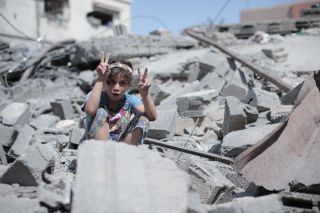KEY POINTS-
- There are significant relationships between auditory stimuli and conflict, and between sound and emotion.
- Certain aspects of these conflict situations are unique and are demanding revised terminology.
- "Human devastation syndrome" has been suggested as a new condition affecting children who face intense PTSD.

The relationship between conflict and trauma is common knowledge; less known is the role that war played in the development of the Diagnostic and Statistical Manual of Mental Disorders (DSM; Guina et al., 2016). Along with their brutality, conflicts are also staging grounds for important changes, from changes in our understanding of the psychology of individuals and groups, to changes in geopolitics, science, and technology. The latter includes the use of new weaponry and, consequently, the creation of human exposure to new stimuli and unprecedented contexts. New stimuli also mean new intensities and varieties of emotional experiences.
Unprecedented Sounds
What is the loudest unexpected sound you have ever heard? It is likely that you can remember the precise moment and are potentially flushed with feelings of discomfort and arousal even when thinking about it.
One of the key functions of emotions is to perceive changes in the environment, typically through perceiving stimuli (Scarantino & de Sousa, 2021). This can be in the form of a novel or startling sound. The weaponization of sound in conflict is often intentional, and not always simply a byproduct of weaponry, such as the use of "sonic booms” to scare urban populations. These forms of auditory stimuli have been found to increase rates of miscarriage (both among humans and animals). The idea that sound and conflict are intimately related is supported by the finding that the top-three reasons military veterans in the United States receive compensation are tinnitus, hearing loss, and posttraumatic stress disorder (PTSD; Guina et al., 2016).
The Syrian government, for example, had dropped nearly 82,000 “barrel bombs” on regions of the country opposed to it as of 2021, according to the United Nations Office for the Coordination of Humanitarian Affairs. These bombs, while rudimentary, are particularly destructive and loud. Given the volume of bombing during the current conflict, the relatively small size of the Gaza Strip, and its high population density, it is likely that most children of the region have been hearing the sound of bombs regularly over the past nearly three weeks.
In Thabet, El-Buhaisi, and Vostanis’s (2014) study on the psychological well-being of Gazan youth in the aftermath of the 2014 conflict there, a few sound-specific findings were reported:
- 89 percent of Gazan children heard shelling by heavy artillery.
- 87 percent of Gazan children saw signs of shelling on the ground.
- 86 percent of Gazan children heard the sonic sounds of fighter jets (including sonic booms).
These noises, when coupled with other trauma-inducing factors, are likely to become a primary cause of PTSD among this population, in part due to the emotions aroused from hearing such threatening sounds.
Other critical contributory factors to PTSD among those living in war zones include the unnatural death of loved ones; the threat of unnatural death and injury; unplanned departures from one’s home; inadequate access to health care and health care facilities; and inadequate access to food, water, and sanitation, among other concerns. The significance of sound stimuli in PTSD is prominent, though, because while most of those other factors will not be typically experienced in postconflict life, unexpected loud noises of various sources remain a part of every person’s life.
Unprecedented Exposure
One of the three clusters of symptoms of PTSD, according to the DSM, Fifth Edition (DSM-5), relates to reliving or re-experiencing elements of war, or other trauma-inducing event, through intrusive memories, flashbacks, dreams, and emotional distress or physical reactivity after exposure to traumatic reminders.
The scale of what occurs among the populations of regions exposed to war, like northern Syria and Gaza, is daunting. Gazan children born prior to December 2008 have now been exposed to conflicts five times. The inherent stop-start nature of these conflicts only makes them more destructive. During a ceasefire, thoughts naturally turn toward wondering when conflict might start up again. In this sense, it can feel as though there is always an impending threat and so the individual, especially a child, will never feel safe.
A typical diagnostic approach is ill-fitting to these contexts. There need to be more nuanced allowances for children and adults living in such conditions, wherein the next “bout” is more a realistic and terrible reality than the conjuring of a mind that is beset with trauma.
American neuropsychologist M. K. Hamza’s coinage of “human devastation syndrome” is one such attempt to account for these challenges with new terminology. His suggested syndrome specifically reflects the level of suffering facing Syrian children amid the brutal conflict that ravaged that country. As he wrote, "I searched the criteria of all psychiatric stressors and traumas and could not find a description for those psychological injuries” (the Syrian American Medical Association, 2016).
Along with the auditory element, another element of modern conflict is unprecedented: secondary exposure through consumption of social media content and social-media-facilitated testimony. We often hear of the risks posed to those distant from the war zone in consuming too much or too gruesome media content; the DSM-5’s treatment of PTSD reflects this. What we hear less about is how this added element plays among those within the conflicts themselves. Those on the ground also consume online content, with the added critical factor that they are witnessing things they themselves might experience in the near future, as well as others they care about. This exposure compounds the issues facing those already at most risk in war.
Conclusion
Diagnostic criteria often take years to be updated. The processes underlying these changes might be ill-suited for a world changing at a fast pace. Conflicts are taking on new natures, in terms of their scale and the stimuli they create, as well as the ways in which people are exposed to them. They are devastating in unprecedented ways, especially for children.


